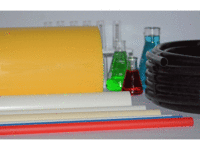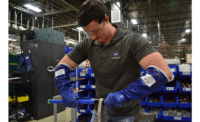As the use of plastic piping (such as ABS, CPVC, PE and PVC) in construction gained popularity, considerable testing and research took place to address issues related to fire performance. Likewise, installation technologies and building codes governing the use of plastic have evolved considerably as performance warranting its use was demonstrated for applications in more demanding building types and occupancies. Consistent with the preceding, that evolution can be traced by comparing descriptions of early technology and regulations related to plastic pipe use1,2 with the current state of the art, as reviewed here.
Plastic Pipe in Fire-Resistive Construction
How does the inclusion of plastic pipe in a room where a fire has started impact the life safety of its occupants? Plastic pipe is routinely installed behind materials that form room "linings," which typically resist a growing fire for 15 minutes or more.3 This feature prevents direct flame impingement on the majority of piping installations.
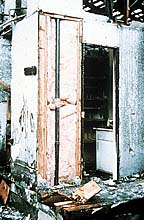
Although a very small fraction of plastic pipe used is exposed rather than installed behind room linings, does the presence of small amounts of such exposed plastic pipe increase the level of fire hazard? Five decades of U.S. fire incident data show no unique hazard or relationship linking plastic piping to unusual fire ignition or fire spread.4 Consistent with this, testing (both fire endurance testing and hose stream tests) and post-fire evaluations of buildings constructed with non-metallic plumbing systems demonstrate that plastic piping materials generally either burn away and char at wall lines (Figure 1), or melt and drop in a wall cavity (Figure 2).
The observed behavior is consistent with the low thermal conductivity of plastic piping materials, which suggests that ignition or the threat of fire spread due to temperature rise (i.e., high temperatures developing) across fire separation walls penetrated by plastic pipe is unlikely. Also, while temperatures in wall cavities may exceed plastic melting temperatures during the early stages of a structural fire (as simulated in the first half-hour of ASTM E-119 testing), they are still well below ignition temperatures of the pipe.5 This behavior is similar to the properties of approved plastic glazing and ceiling inserts designed to fall to the floor of the affected rooms before their ignition point is reached. Consistent with this, Figure 3 illustrates the condition of an unburned segment of plastic DWV pipe within a test wall cavity after a 30-minute ASTM E 119 fire exposure.

Figure 2. Vent and DWV stacks post fire. ABS remains in concealed spaces. Note charring of adjacent wood.
Design Specifications
Design features requiring fail-safe fire-resistant detailing are typically needed at locations where building services cross floor-to-floor or unit-to-unit boundaries. Building sub-systems routinely found at such locations include plumbing, electrical and hvac components.
Openings in fire-resistive walls--penetrations--for plastic pipe must be addressed in design specifications. The term "through penetration" refers to openings that transverse a fire-resistive assembly, while membrane penetrations contain openings on one side only. The latter class of penetrations includes single-sided plumbing penetrations. Openings for all such penetrations in both walls and floor/ceilings must be protected to prevent unwanted fire spread and spread of smoke and hot gases.
Flame spread performance is another property typically addressed by the codes. Regulations governing the use of plastic pipe or any other combustible building product installed in air handling spaces are found in both mechanical codes and NFPA 90A.
The impact that combustion products from burning plastic pipe installed in fire-resistive construction may create on life safety deserves comment. A first consideration is the amount of plastic piping used. Analysis demonstrates that this quantity is relatively small--especially when compared with other combustible construction materials and furnishings. In addition, combustion products created when plastic piping burns do not evolve early in a fire due to how and where they are installed. In addition, testing and field data indicate that resulting gases are no more toxic than other common building and furnishing materials.14-17
Firestopping
In the 1970s, initial testing of plastic piping installations in fire-resistive assemblies was conducted with walls containing both metal and wood stud structural elements.6-13 In both cases, the use of the plastic plumbing pipes did not reduce fire endurance, provided that the penetrations were not oversized and they were sealed properly. More recent test results conducted under positive pressure testing conditions assure that such installations will resist transmission of hot gases to unexposed specimen surfaces.
Overall, fire endurance tests of cavity wall constructions that include plastic pipe demonstrate that successful installations can be made using generic firestopping for smaller diameters of pipe and approved penetration firestop systems for larger diameters of pipe. In such test exposures, conducted at federal and university labs as well as third party testing facilities, horizontal through penetrations made with small diameter plastic pipe (1.5" (37.5 mm) or less) melted quickly and at the back, while unexposed wall surfaces sealed off and no flame passage occurred.6-13 In the same tests, vertical drain and vent sections melted and dropped within the wall, without flaming occurring on unaffected back-face wall surfaces, as shown in Figure 3, taken after a 30-minute ASTM E-119 fire exposure. By firestopping penetrations with appropriate, approved materials and techniques, the fire-resistance properties of the penetration can be made equal that of the original, unpenetrated assembly. This performance has been demonstrated in literally hundreds of fire endurance tests with a wide range of pipe and firestopping materials, as well as wood, steel and masonry structural systems. Abbreviated listings of results for such tests can be found in listing directories or Web sites of accredited, third party testing agencies such as ITS Intertek Testing Services, Omega Point Labs and/or Underwriters Laboratories, Inc.
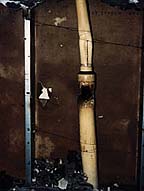
Figure 3. Appearance of PVC DWV specimen following 30-minute E-119 hose stream exposure.
History of Plastic Pipe Regulations
In the 1960s and 1970s, building code regulations used to define fire endurance requirements prescribed the ASTM E-119 method, which did not specifically address:
- measurement of (allowable) temperatures on piping assemblies,
- furnace pressure at which testing was to be conducted, or
- allowable penetrating element configurations.
These issues were relevant because, during a fire, pipe installations that were vented could be expected to behave differently from unvented ones. In addition, metallic pipe and plastic pipe systems could be expected to conduct heat through affected assemblies differently. This performance attribute was demonstrated during development of the ASTM E-814 standard, in which the thermal response of metallic-penetrating elements such as pipes or sleeves varied significantly depending on the length of sample--a direct consequence of thermal conductivity and exposed pipe surface area.18
As the volume of the plastic pipe use has grown, marketplace competition has been vigorous. The interested parties include manufacturers of competing plumbing product materials (usually metallic pipe manufacturers), as well as unions and cost-plus contractors that have seen their markets and margins shrink. Regulators have been drawn into this controversy, as occasionally specious technical arguments have been advanced to limit the expanded use of plastic pipe systems.19, 34, 35
In the late 1970s, partially in response to the growing controversy over how best to test plastic pipe installations in fire-resistive construction, the ASTM E05 committee developed the ASTM E 814 Standard (Standard Test Method for Fire Tests of Through-Penetrations Fire Stops, also known as UL 1479 and UBC Std 7-5), which was first approved in 1983. This method addressed shortcomings of the more general ASTM E 119 method and clarified testing criteria for through penetrations of fire-rated assemblies.
In the 1980s, code changes to address the use of plastic pipe, tube and conduit in fire-resistive construction were advanced in the model codes. Similar activities by the Council of Building Officials-Board for the Coordination of the Model Codes (CABO-BCMC) resulted in the "Final Report on Protection Requirements for Vertical Penetrations" in 1986.20 Almost a decade later, in 1995, the BCMC guidelines were updated further with publication of the report "Protection of Penetrations and Joints in Building Wall, Floor and Roof Assemblies."21
One result of these activities has been a requirement for testing under positive furnace pressures today. Such testing is conducted in the range of 0.01" of water column (2.5 Pascal) to simulate worst case conditions found in post flashover fires. BCMC was the first group to adopt such a positive pressure caveat in its guidelines.
Unfortunately, positive pressure testing has also called into question the results of early testing of pipe penetrations in furnaces where a variety of pressures were used. While no field data suggesting shortcomings in the results or implications of those early tests has been presented, the concept is important from a theoretical perspective in that structural fires do not show uniform pressures from floor to ceiling. Rather, maximum positive pressures are found in the top third to half of affected rooms, while pressures below are typically negative and may actually encourage an inflow of cooling air at through penetrations low on walls, where drains for sinks are located.22 Likewise, pressures above atmospheric are not uncommon in tall buildings due to stack effects.
Installation information for plastic pipe in fire-rated construction was first provided in an organized format in 1985.23 That document, "Plastic Pipe in Fire Resistive Construction," was the subject of a CABO National Evaluation Report in 1992, and two later editions of this document have been published.24
Historically, the model code organizations also produce plumbing codes that address performance of piping materials and systems. These generally do not address fire safety issues. An exception to this has been the Uniform Plumbing Code25, which before 1999 severely restricted use of plastic pipe in fire-resistive buildings. That code was modified in 2000 to allow unlimited use of plastic pipe in construction of all types.
The International Building Code26 (IBC) includes comprehensive provisions for plastic piping system applications in fire-resistive construction. IBC Sections 603 (Combustible Material in Type I and II Construction) and 711 (Penetrations) address conditions and requirements for use of plastic piping materials in all building types, including those with non-combustible structural frames.
In 1991, the NFPA 101 Life Safety Code recognized and addressed the importance of protecting through penetrations in fire-resistive construction for piping as well as for non-metallic electrical raceway systems. That code utilizes the ASTM E-814 test method and includes a table of performance requirements for penetrations with both metallic and non-metallic piping types. These provisions are based upon the BCMC report21 and are contained in an appendix note found there.
Initial ASTM E-119 and later E-814 fire testing of penetrations incorporating plastic pipe has provided model code developers an improved understanding of the characteristics and properties of plastic pipe used in structures as compared to what was available 25 years ago. Testing archives include literally thousands of fire endurance test reports based on assembly testing by accredited third party testing labs and research institutes.
Fire Performance Guidelines
It is extremely rare for a fire-resistive assembly to be built exactly as found in the generic form described in the tables of model building codes or the Gypsum Association Handbook.27 However, thermoplastic piping materials tend to behave similarly on exposure to fire and certain "rules of thumb" can be applied to evaluate and analyze performance in various installations. In 1965, Harmathy28 presented a seminal analysis on the performance of fire-rated assemblies that is of use to reasonably predict the impact of design variables in the field. Several of those rules, paraphrased from the HUD Guidelines for the fire performance of archaic building materials29, are reviewed below in the context of plastic piping applications.
Rule #1: Thicker assemblies (such as walls and floor ceilings) will--with all other factors being held constant--last longer than thinner walls of the same composition exposed to the same fire conditions.
Rule #2: Fire-resistive assemblies containing hollow spaces tend to outperform similar analogs composed of the same materials without hollow spaces.
Rule #3: Insulated assemblies can be expected to perform better than un-insulated ones.
Rule #4: Smaller openings in walls will lead to lesser diminution of fire endurance than larger openings.
As such, if a fire-resistance rated assembly is deeper or thicker than a tested assembly, it will last longer whether or not it includes piping. If insulation is present in a rated design that was originally tested without insulation, whether or not it includes piping, the insulated wall will last longer than the un-insulated version. If a wall is tested with a given size of penetration, the presence of a smaller penetration than the one originally tested will not reduce its fire endurance.
Acceptance of Plastic Pipe Systems in Fire-Resistive Construction
A 1978 survey of high-rise buildings identified 108 high-rise or non-combustible buildings in 28 states that had been constructed using plastic piping for DWV systems.30 This survey was completed eight years before the first regulatory efforts to specifically address use of plastic piping products in such applications took place. To the author's knowledge, all of these systems are still in use, and none have suffered fire-related problems. No other systematic data exists quantifying the use of plastic pipe in such complex structures in relation to fire performance, although we are aware that these materials are routinely used in fire-rated buildings in many parts of the world today.
In 1983, a draft Environmental Impact Report31 was published in California to address the expanded use of plastic pipe and the lack of regulations in that state. Based in part on the first draft of that study, Stanford Research Institute (SRI) issued a report in 198932 and the State of California, Department of Housing and Community Development, published a final report in 199833 endorsing the use of plastic pipe in fire-resistive construction.
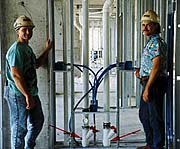
Figure 4. Chase wall including firestopping devices and PVC plumbing installation.
Plastic Pipe and Sprinkler Systems
Plastic piping materials used in sprinkler systems have had a significant impact on fire safety, and their use has grown significantly over the past 15 years. Initially, fire protection and cost/benefits provided through use of such systems substantially impacted both fire safety levels in single-family dwellings and in light hazard occupancies. Performance consistent with provisions of NFPA 13 was demonstrated in early testing at Underwriters Laboratories beginning in 1985 and 198736,37, with revisions in 1987, 1989 and 1990. That testing included both functional testing of unprotected piping systems to wood crib and heptane fire plume exposures as well as testing of individual system components and design elements. In addition, fire tests in buildings have taken place in Palo Alto, CA (1972/73--14 tests); University of MD (1974--3 tests); Tacoma, WA (1975, 1977--6 tests total); Atlanta (1975--1 test); and Columbus, OH (1967--11 tests). A major test program was also conducted in San Francisco by the International Association of Fire Chiefs, which was reported on in 1984.38 A comprehensive review of initial plastic pipe-based sprinkler systems development efforts was published by Wilging in 1988.39 Demonstrations that such CPVC-based sprinkler systems were acceptable for use in air-handling spaces--as regulated by the model mechanical codes and the NFPA 90A Standard--have also assisted in this growth.
At this point, plastic pipe-based sprinkler systems can be used with both exposed piping (when fast response sprinklers are used) and with standard response sprinklers for concealed piping. They cannot be used in dry-pipe systems and must not be installed with other types of plastic piping materials, such as those used for supply or DWV piping.
Conclusion
Based on the testing and analysis available, no credible data exists from which it can be inferred that plastic pipe cannot be used safely in fire-resistive construction.
From a historical perspective and the volume of information available, efforts to test and evaluate the fire performance of plastic pipe systems have far exceeded those conducted for any other piping materials used today. In addition, fire incidence data support the continued use of these products in all occupancies.
Complementing this record is the success of plastic pipe-based fire sprinkler systems in mitigating fire losses over the past 15 or 20 years. The favorable economics of such systems have allowed sprinkler protection to be extended to numerous classes of buildings where costs of other options eliminated sprinklers from the cost benefit mix.
Overall, properly installed, plastic piping installations present no greater fire risk than other types of piping materials available on the market today.
References
- Favro, P.C. and J. Sacco, 1980. "Fire Hazards of Plastic Pipe," Report to the State of California Commission on Housing and Community Development (HCD).
- Williamson, R.B., 1979. "Installing ABS and PVC Drain Waste & Vent Systems in Fire Resistant Buildings," Fire Journal, pp 36-45.
- Zicherman, J.B., 1992. "Performance of Plastic Plumbing and Electrical Products in Fire-Resistive Assemblies," Fire Hazard and Fire Risk Assessment, ASTM STP 1150, M. Hirschler, Editor.
- Hall, J. Personal communication, 1999.
- Wilging, R.C., 1996. "Is Expansion a Problem in Plastic Piping?" PM Engineer, 2(1): 25-29.
- Williamson, R.B., 1985. "Fire Test of a Six-Inch Wood Stud One Hour Fire Rated Wall with a Polyvinylchloride DWV Plumbing System," Fire Test Report 76-7, University of California, Berkeley.
- McGuire, J.H., 1973. "Penetration of Fire Partitions by Plastic DWV Pipe," Fire Technology, Vol 9, No.1.
- McGuire, J.H., P. Huot, 1971. "Fire Tests Concerning the Penetration of Walls by Horizontal Plastic DWV Pipes," National Research Council of Canada, Technical Note No. 557.
- McGuire, J.H., 1974. "A Full-Scale Fire Test of a Wall Penetrated by Plumbing Facilities," Building Research Note, National Research Council of Canada.
- Parker, W.J. et al., 1975. "Fire Endurance of Gypsum Board Walls and Chase Containing Plastic and Metallic Drain, Waste and Vent Plumbing Systems," NBS Building Series Report No. 72, National Bureau of Standards, Gaithersburg, Maryland.
- Bletzacker, R.W. and J.G. Birle, 1974. "Standard ASTM Fire Endurance Test on a Floor and Ceiling Assembly," Engineering Experiment Station Report Project 5539, Ohio State Univ.
- Bletzacker, R.W, 1984. "Standard ASTM Fire Endurance Test and Fire and Hose Stream Test on Duplicate Load Bearing Poly Vinyl Chloride Plumbing Wall Assemblies," Engineering Experiment Station Report, Project 5561, Ohio State Univ.
- Bletzacker, R.W. and J.G. Birle, 1973. "Standard ASTM Fire Endurance Test and Fire and Hose Stream Test on Duplicate Non-Load Bearing Acrylonitrile-Butadiene-Styrene (ABS) Plumbing Wall Assembly," Engineering Experiment Station Project Report No. 5473, Ohio State Univ.
- Benjamin, I.A., 1987. "Toxic Hazards Analysis: Electric Non-Metallic Tubing," J. Fire Sciences, 51:25-49.
- Clarke, F.B., 1983, "Toxicity of Combustion Products: Current Knowledge," Fire Journal, 77(5): 84-108.
- Clarke, F.B. and S. Steele, 1990, "How Do Burning Products Affect Life Safety?" Fire Journal, 84(6):48-55.
- Bukowski, R. et al., 1990. "Fire Risk Assessment Methods: Case Study 3 Concealed Combustibles in Hotels," NISTIR 90-4245, National Fire Protection Research Foundation, Quincy, MA.
- Priest, D. Personal communication, 1999.
- Flax, S., 1983. "Dubious War on Plastic Pipe," Fortune Magazine, 107(3):68-71.
- BCMC Public Hearings, 1986. "Final Report on Protection Requirements for Vertical Penetrations," Kansas City, MO.
- BCMC Public Hearings, 1995. "Protection of Penetrations and Joints in Building Wall, Floor and Roof Assemblies," Orlando, FL.
- Lee, B.T., 1985. "Standard Room Fire Test Development at the National Bureau of Standards," In: Fire Safety: Science and Engineering, ASTM STP 882, T.Z. Harmathy, Ed., Philadelphia, PA, pp. 29-44.
- Plastic Pipe and Fittings Association, 1985, 1991, 1997. "Plastic Pipe in Fire-Resistive Construction," Editions 1-4, Glen Ellyn, IL.
- Council of American Building Officials, 1992. "Plastic Pipe in Fire-Resistive Construction," National Evaluation Report NER-370.
- International Conference of Building Officials, 1997. "Uniform Building Code." Walnut, CA.
- International Code Council Inc., 2000. "International Building Code 2000." Falls Church, VA.
- Gypsum Association, 2000. "Fire Resistance Design Manual," 16th Edition, Washington, DC.
- Harmathy, T.Z., 1965. "Ten Rules of Fire Endurance Rating," Fire Technology, 1(2).
- U.S. Department of Housing and Urban Development, 2000. "Guidelines on Fire Ratings of Archaic Materials and Assemblies," Rehabilitation Guidelines Series.
- Plastic Piping and Fittings Association, 1978. "Plastic Pipe and Fire Safety: The Model Building Codes, Fire Test Work and a Historical Perspective," prepared for State of California Department of Housing and Community Development.
- SRI International, 1983. "Environmental Review of Proposed Expanded Uses of Plastic Plumbing Pipe," SRI project No. HSH-4910.
- Alger, R. S., 1989. "Technical Appendices D," in Draft Environmental Impact Report: Plastic Plumbing Pipe; State of California Department of Housing and Community Development, Sacramento, CA.
- State of California Housing and Community Development, 1998. "Final Environmental Impact Report for Chlorinated Polyvinyl Chloride Pipe Use for Potable Water Piping in Residential Buildings," California State Department of Housing, Sacramento, CA.
- Zicherman, J.B., 1990, "Cost Benefit Studies of PVC Pipe Tube and Conduit," presentation to CSI-Construction Specifics Institute Annual Meeting, San Diego, CA.
- The Vinyl Institute, 1990. "Cost Benefit Studies," The Vinyl Institute News, July.
- Underwriters Laboratories, 1985. "Report on cPVC Pipe and Fittings for Sprinkler Systems," Project 87NK837.
- Underwriters Laboratories, 1987. "Report on cPVC Pipe and Fittings for Sprinkler Systems," Project 87NK4110.
- Clarke, B., 1984, "Operation San Francisco: Smoke/Sprinkler Test," Technical Report, International Association of Fire Chiefs, Washington DC.
- Wilging, R.E., 1988. "Plastic Fire Sprinkler Piping 1967-1987," BOCA Magazine, July/August.
